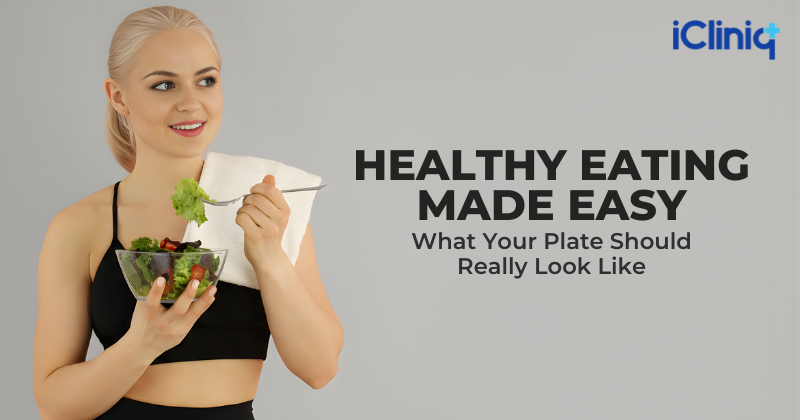Healthy Eating Made Easy: What Your Plate Should Really Look Like

Building a Balanced Plate: The Simple Art of Healthy Eating
Healthy eating doesn’t have to be complicated. It’s not about strict diets or depriving yourself of your favorite foods; it’s about balance. It all begins with how you build your plate. The Healthy Eating Plate model is a simple visual guide to help you put together meals that are colorful, varied, and packed with nutrition. Let’s break it down step by step.
Fill Half of Your Plate with Fruits and Vegetables
Make your meals revolve around vegetables and fruits; they should take center stage on your plate. These foods are rich in vitamins, minerals, antioxidants, and fiber, all of which are essential for maintaining good health.
Try to include a rainbow of colors: leafy greens like spinach and kale, bright oranges from carrots or pumpkins, deep reds from tomatoes and peppers, and purples from berries or eggplants. Each color provides a unique set of nutrients, so variety truly matters.
Choose Whole Grains for One-Quarter of Your Plate
The next portion of your plate should feature whole and intact grains. Instead of refined options like white rice or white bread, choose grains that are minimally processed and still contain their natural nutrients.
Options such as brown rice, quinoa, barley, oats, or whole wheat bread not only taste great but also provide sustained energy. Whole grains take longer to digest, helping you feel full for longer periods and preventing energy crashes between meals.
This simple swap makes a big difference in maintaining stable blood sugar levels and supporting overall digestive health.
Add Healthy Proteins for the Remaining Quarter
Protein is your body’s building block, essential for muscle repair, hormone production, and cell health. For the remaining quarter of your plate, choose lean and healthy sources of protein.
Include foods like fish, poultry, beans, lentils, tofu, and nuts. These options supply not only protein but also healthy fats, vitamins, and minerals.
Try to limit red meat and avoid processed meats such as sausages, bacon, and deli slices, which are often high in salt, preservatives, and unhealthy fats. A balanced protein intake can make you feel more satisfied and help maintain long-term health.
Use Healthy Oils in Moderation
Fat is not your enemy; it’s about choosing the right kind. Healthy fats play a key role in heart and brain health. When cooking or preparing salads, reach for plant-based oils like olive, sunflower, or canola oil. These contain beneficial unsaturated fats that support your cardiovascular system.
At the same time, stay away from trans fats and highly processed oils, often found in fried foods, baked goods, and packaged snacks. A small drizzle of the right oil can go a long way in adding flavor and nourishment.
Drink Smart
What you drink is just as important as what you eat. Make water your go-to beverage, as it keeps your body hydrated and supports every cellular function. You can also enjoy tea or unsweetened coffee in moderation. Limit your dairy intake to 1–2 servings per day; for example, a cup of milk or a serving of yogurt.
As for fruit juices, enjoy them occasionally in small portions, since even 100% fruit juice can be high in natural sugars. Avoid sugary drinks and sodas, as they add empty calories without any nutritional benefit.
When you fuel your body with the right foods, it rewards you with energy, strength, and long-term health. Your body truly will thank you.





